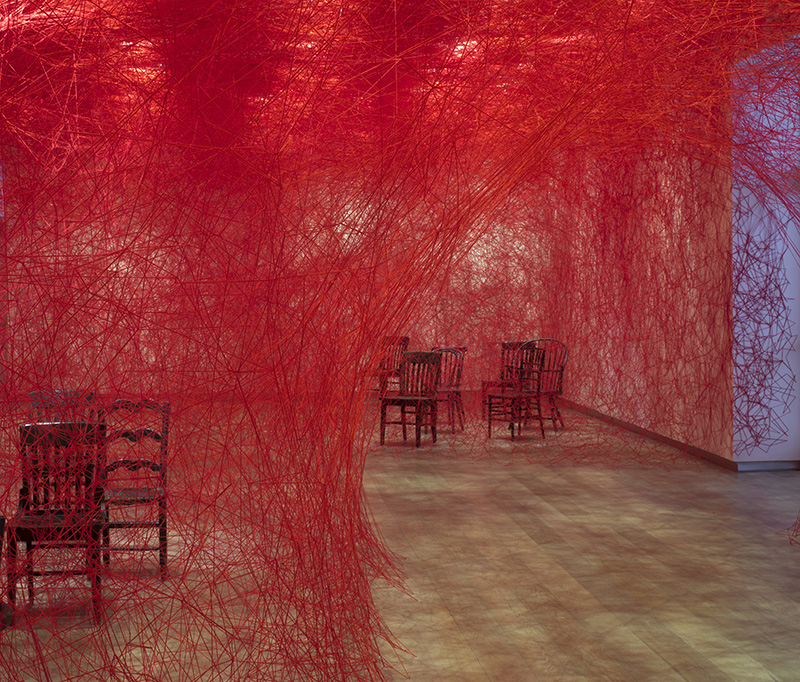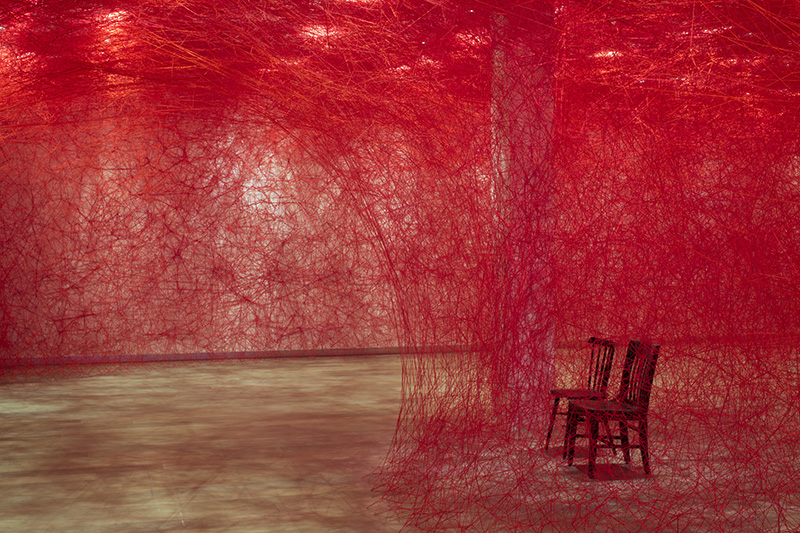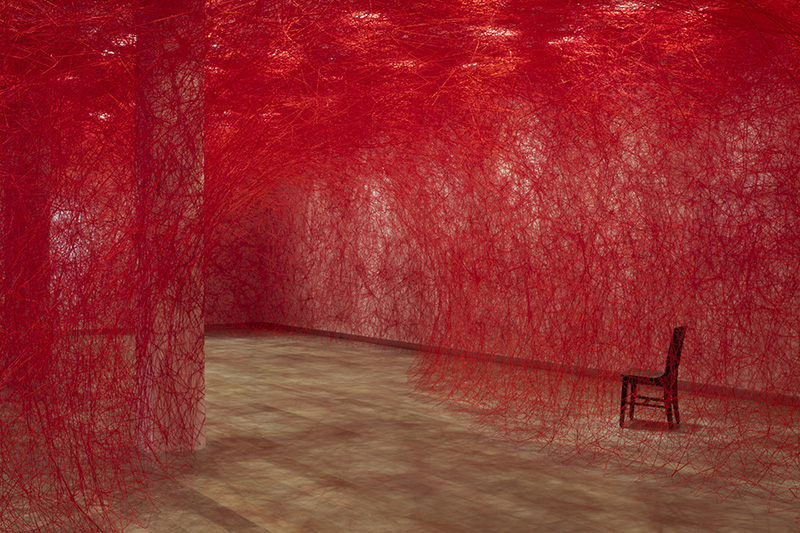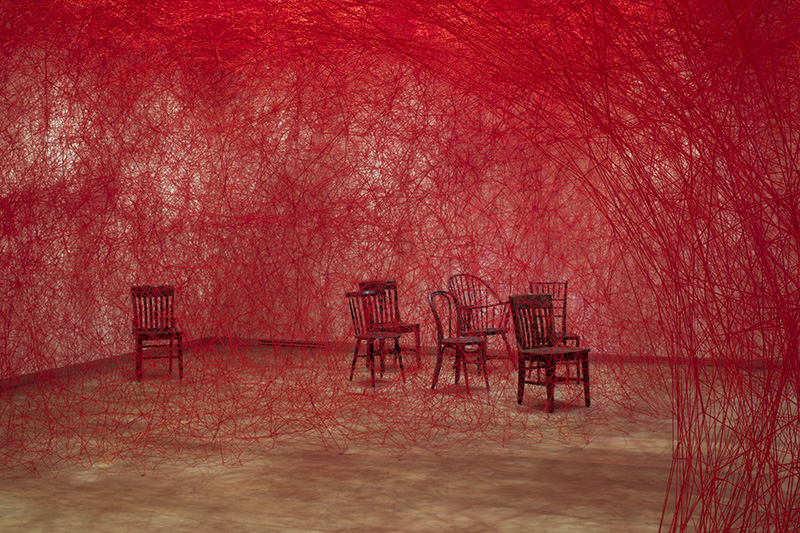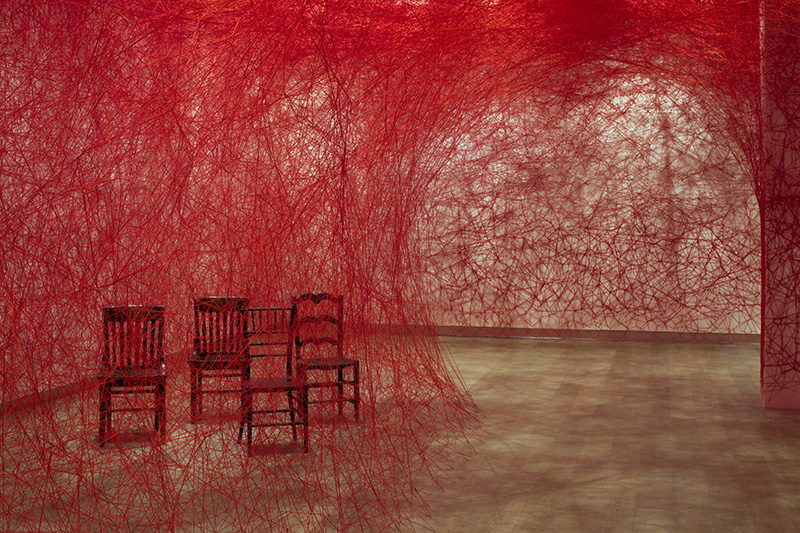INTERVIEW: Chiharu Shiota
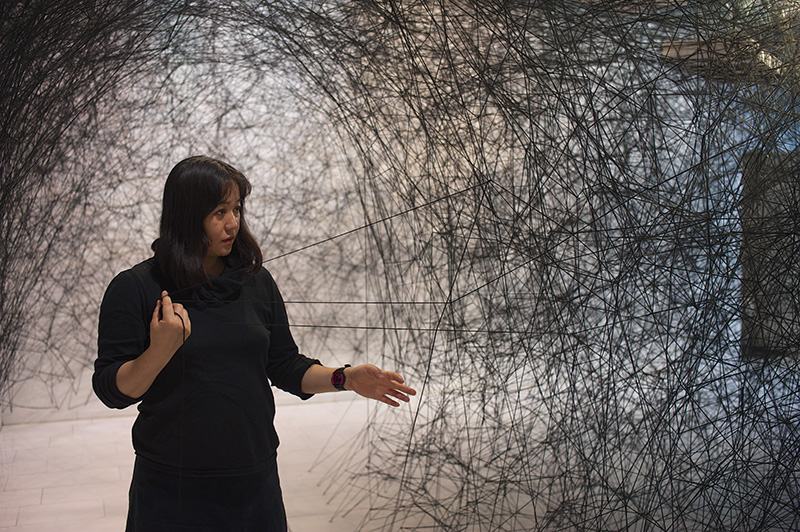 The starting points for the majority of Chiharu Shiota’s installations are collections of used everyday objects that act as expressions of human acts. Complex networks of yarn are interlaced around and between the objects, linking their inherent narratives and creating a new visual plane, as if painting in mid-air, to explore the relationship between living and dying and to access memories found within these objects. For “Infinity Lines”, a site specific commissioned installation at the SCAD Museum of Art in Savannah, Georgia, as part of SCAD’s annual program of exhibitions and events called deFINE ART, Chiharu Shiota has incorporated antique wooden chairs with red yarn connecting one chair to another and also to the surfaces of the gallery itself, filling the space and tying individual stories and memories together. As Chiharu Shiota says “… Uncertain Journey means to express the unclear purpose or direction in life. We are going somewhere but we don’t know where exactly. We travel through the uncertainty of life by asking ourselves questions that we cannot answer sometimes”.
The starting points for the majority of Chiharu Shiota’s installations are collections of used everyday objects that act as expressions of human acts. Complex networks of yarn are interlaced around and between the objects, linking their inherent narratives and creating a new visual plane, as if painting in mid-air, to explore the relationship between living and dying and to access memories found within these objects. For “Infinity Lines”, a site specific commissioned installation at the SCAD Museum of Art in Savannah, Georgia, as part of SCAD’s annual program of exhibitions and events called deFINE ART, Chiharu Shiota has incorporated antique wooden chairs with red yarn connecting one chair to another and also to the surfaces of the gallery itself, filling the space and tying individual stories and memories together. As Chiharu Shiota says “… Uncertain Journey means to express the unclear purpose or direction in life. We are going somewhere but we don’t know where exactly. We travel through the uncertainty of life by asking ourselves questions that we cannot answer sometimes”.
By Efi Michalarou & Dimitris Lempesis
Photo: SCAD Museum of Art Archive
Mrs Shiota, your artwork wakes and brings back memories that refer to the home with its objects like chairs or pianos, but also everyday objects like suitcases and keys. All these objects are floating in space and time, trapped and connected through the yarn that you are using in your installations, creating a world that balances between fiction and reality, freedom and entrapment, which resembles a spider web. Personally do you feel this entrapment?
The weaving process is a way of conveying existence in the absence. I would say it is the other way round. By creating webs, I tend to wrap individual memories and shine a light on human relationships. Whenever my mind is going through many thoughts that cause me pain or worry, I find a way to express those feelings through art and sometimes it is the only form that helps me heal inside and feel better. When I do an installation I can let go of that feeling easily. I make peace with myself.
In your solo exhibition at SCAD, you present “Infinity Lines”, a site specific installation that incorporates antique wooden chairs that show evidence of their previous use, red yarn connects one chair to another and also to the surfaces of the gallery. The color of the yarn in your work toggles between black and red. Why did you choose the chairs? What they represent for you and what the red yarn?
The theme of all my works is Existence in the Absence in order to explain the trace of a person and the way I convey these aspects is through empty chairs which immediately lead us to their individual memory. The thread connects one chair to the other working its way from one point to another by means of bringing humans together through a line of interconnectivity just as the neurons of the human brain work. This red web blending in with the chairs functions as the complexity of the human brain.
How does physical or mental pain affect you in your work? Since a lot of times, we are facing pain and the fear of death, emotions very close to the human beings, also the loss, sometimes these emotions become a cause for creation and sometimes they are trammels.
I need all these emotions to help me create. It is necessary for me to make art.
As we know, through a very nice mistake, in your art studies in Germany you studied under the very important performer Marina Abramović, an artist who is exploring the pain and the limits of the human body. What were you taught by her practice? How much do you consider that Marina Abramovic influenced you and your work?
She told me not to use string because it was already something I was perhaps too familiar with.
Mrs Shiota, through your work the personal experience transforms to universal. Do you think that the contemporary way of life is so confusing?
Every day we are targeted and surrounded by information. Humans develop in a very fast pace but our human body is not adapting and changing at the same speed so it is becoming more complex to find the real meaning of life. We assume the information given but we also lose the key message that we are trying to grasp and understand. Each time it is becoming more complicated to understand the sense of belonging.
Do you agree if the human being can escape from this?
It is difficult to choose whether we escape or not. I think everything is connected. They go hand in hand. It is about choosing our way of life.
You originate from Japan, a country that is characterized by wisdom. A country that has taught us various methods of balancing the mind and the soul. If we change the relationship between objects and yarn in your artwork, like: “Uncertain Journey”, an artwork that really stands out, are you presenting us also the bright side of life?
It is actually the complete opposite. “Uncertain Journey” means to express the unclear purpose or direction in life. We are going somewhere but we don’t know where exactly. We travel through the uncertainty of life by asking ourselves questions that we cannot answer sometimes.
In parallel with your exhibition at SCAD, there were also educational programs in which you participated. Would you like to tell us about your experience with the students, how exciting it was for you and what were the reactions?
The students were of great help with my installation. They had a lot of energy and enthusiasm about their art carriers so they were eager to learn. They reminded me of my first years as an art student, having that positive mindset about the art scene and the future.
NB: The installation was produced in close collaboration with the SCAD fibers department and students worked with Chiharu Shiota to create this installation. The largest of its kind in the US, SCAD fibers department has a comprehensive curriculum and large, inspiring facilities stocked with top-of-the-line tools and resources. SCAD offers accredited B.F.A., M.A. and M.F.A. degrees in fibers and alumni have gone on to land jobs for leading companies like Anthropologie, Urban Outfitters, Martha Stewart Living, Diane von Furstenberg, and Lilly Pulitzer etc. SCAD students are the heart of this teaching museum; they attend academic classes and career workshops, lecture series, film screenings, gallery talks and annual events within its storied walls. They also serve as museum docents, welcoming visitors, interpreting the exhibitions and interacting with illustrious museum guests. As a center for cultural dialogue, the SCAD Museum of Art engages students through dynamic, interdisciplinary educational experiences.
Info: Curator: Aaron Levi Garvey, Assistant Curator: Amanda York, SCAD Museum of Art, 601 Turner Blvd., Savannah, Georgia, Duration 21/2-6/8/17, Days & Hours: Tue-Wed & Fri-Sat 10:00-17:00, Thu 10:00-20:00, Sun 12:00-17:00, www.scadmoa.org
Download Greek version here.
First Publication: www.dreamideamachine.com
© Interview – Efi Michalarou & Dimitris Lempesis
